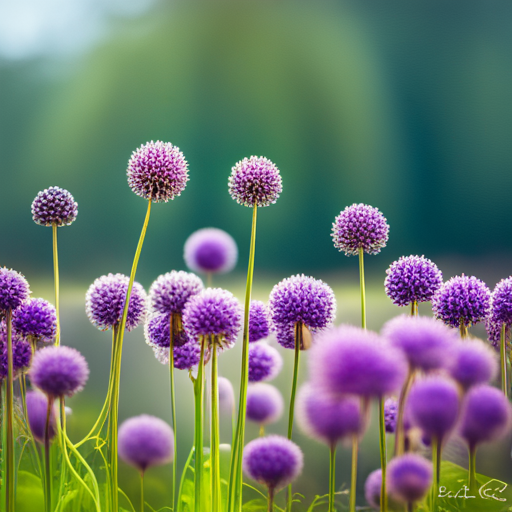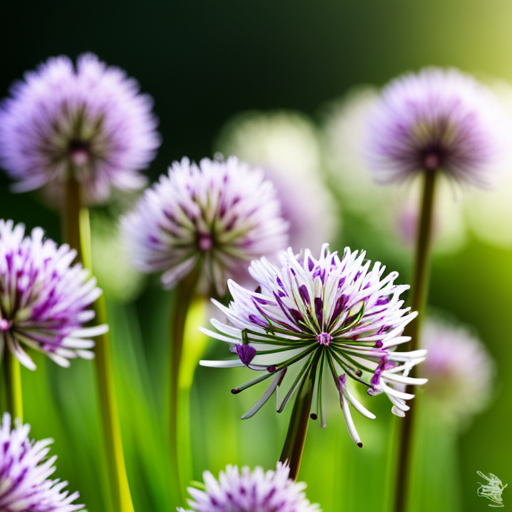
Are you a fan of beautiful blooms that add color and texture to your garden? Alliums are the perfect addition to any garden! These stunning bulbs are easy to care for and come in a variety of colors and sizes. If you’re wondering how to plant allium bulbs, when to plant them, how to prepare soil, how deep to plant them. And how to take care of them when they come up in the spring – look no further! In this post I will share my tips and tricks on how to plant Allium bulbs and how to care for them.
When to Plant Allium Bulbs for Each Zone Type
Timing is everything when it comes to planting allium bulbs. Different climate zones have different optimal planting times to ensure the best growth and most vibrant blooms.
Zone 3-4: In colder climates, like Zones 3 and 4, plant allium bulbs in late September to mid-October. This gives the bulbs enough time to root before the ground freezes.
Zone 5-6: For Zones 5 and 6, you should plant alliums a bit earlier, typically in early to mid-September.
Zone 7-8: If you’re in a warmer climate, like Zone 7 or 8, plant your allium bulbs in late September to early October.
Zone 9-10: And for those in the warmest climates, Zones 9 and 10, you can plant allium bulbs in October to early November. This later planting gives the bulbs a chance to enjoy cooler soil temperatures, which promotes better root development.
Remember, alliums are a spring-flowering bulb, so they need a period of cold dormancy to bloom. Plan accordingly based on your hardiness zone and enjoy the beautiful flowers in the spring!
How to Prepare the Soil for Allium Planting
Preparing the soil correctly is crucial for your alliums to thrive. Alliums prefer soil that is well-draining and rich in organic matter. To prepare the soil, start by removing any weeds or debris from the planting area. Next, amend your soil with organic compost to enrich it and improve the soil structure. If your soil is heavy clay, consider adding some sand or grit to improve the drainage.
Check the soil’s pH level as well. Alliums do best in slightly acidic to neutral soil, with a pH between 6.0 and 7.0. If your soil pH is too high (alkaline), add some garden sulfur to lower it. If it’s too low (acidic), add some garden lime to raise it. This soil meter is perfect for checking pH level, nutrient levels and moisture content.
Once you’ve made these amendments, give the soil a good turn with a garden fork or tiller to mix everything in and aerate it. This prepares the soil for the allium bulbs to easily take root. And also access the nutrients they need to grow and bloom beautifully.
How Deep to Plant Allium Bulbs
A crucial aspect to consider while planting allium bulbs is the depth at which they are planted. The rule of thumb here is to plant bulbs two to three times their own depth. For instance, if your allium bulb is 2 inches tall, you should plant it 4 to 6 inches deep. This guideline applies to all types of allium bulbs, regardless of their size. Alternatively, you can calculate the depth by measuring the height of the bulb and multiplying it by two or three. Remember to always point the tip of the bulb upwards when planting. Proper planting depth ensures better root establishment, provides sufficient insulation during winter, and results in healthier, more vibrant blooms in spring.
How to Grow and Care for Allium Bulbs
Once you’ve planted your allium bulbs at the right depth, it’s time to focus on their growth and care. Alliums thrive in full sun and well-drained soil. Here are some general guidelines for growing and caring for your allium bulbs:
Watering-While alliums are fairly drought resistant, they do best with consistent watering, especially during dry spells. Water your allium bulbs thoroughly after planting and continue to provide them with a deep watering once a week. However, be careful not to over-water as this can lead to bulb rot.
Fertilizing-Alliums aren’t heavy feeders but will appreciate a feeding of all-purpose bulb fertilizer in the early spring when their shoots first appear. Continue feeding every three to four weeks during the growing season.
Mulching-A layer of mulch around your allium plants will help retain moisture, suppress weeds, and provide added protection for your bulbs through the cold winter months.
Pruning-Once your alliums have finished blooming, allow the foliage to die back naturally. This allows the plant to gather energy for next year’s bloom. Only remove the leaves once they have completely yellowed and died off.
Remember, alliums are perennials, which means they will return year after year, giving you a beautiful and vibrant garden display with minimal effort!
How Tall do Alliums Get?
Depending on the specific variety, the height of alliums can greatly vary. On the smaller end, some alliums such as Allium Moly, a popular garden variety, can reach heights of 10 to 15 cm (4-6 inches). Medium-sized alliums like Allium ‘Purple Sensation’ can grow to around 90 cm (35 inches). However, the tallest alliums, like Allium ‘Globemaster’ or Allium giganteum, can tower at a range of 120 to 150 cm (47 – 59 inches). It’s this impressive height range combined with their vibrant blooms that make alliums a standout addition to any garden. Keep in mind that the height of your alliums can also be influenced by the quality of their care and the conditions of your garden.
Different Types of Alliums and Their Features
Alliums are a large and diverse family of plants. Here are a few notable varieties:
- Allium Moly (Allium moly): This variety is known for its golden yellow, star-shaped flowers that bloom in late spring to early summer. Allium Moly is a small type of allium, reaching heights of 10 to 15 cm (4-6 inches), making it ideal for borders or for planting in rock gardens.
- Purple Sensation (Allium ‘Purple Sensation’): As the name suggests, this variety is known for its striking purple blooms. The flowers are round and densely packed, creating a dramatic visual effect. Purple Sensation can grow to around 90 cm (35 inches) and is a favorite in many gardens for its vibrant color and height.
- Globemaster (Allium ‘Globemaster’): One of the largest alliums, Globemaster can reach heights of 120 to 150 cm (47 – 59 inches) and produces enormous, spherical blooms of purple flowers. This variety is a true showstopper and is commonly used as a focal point in garden design.
- Allium Giganteum: Similar to the Globemaster, Allium Giganteum is known for its height and large, spherical blooms. Its flowers are a slightly lighter shade of purple and can reach diameters of up to 15 cm (6 inches).
- Allium Sphaerocephalon (Drumstick Allium): This variety has unique, egg-shaped flowers that start off green and gradually turn a deep purple as they mature. The individual flowers are densely packed on the top third of the stem, creating a striking visual effect. Drumstick Allium typically reaches heights of 60 to 90 cm (24-35 inches).
Each of these alliums have their own unique characteristics and can add different elements of beauty and interest to your garden. Choose the varieties that best meet your landscaping goals and enjoy their spectacular blooms each spring!
Happy Gardening!

Alliums are a perfect addition to any garden. With proper care, these stunning bulbs can add beauty and texture to your outdoor space. Now that you know how to plant allium bulbs, when to plant, how to prepare soil, how deep to plant the bulbs, and how to care for them when they come up in the spring. You are ready to start planting and enjoy the beauty of allium flowers in your garden. Don’t forget to deadhead blooms once they have finished, and look forward to propagating your allium bulbs in the Fall.
Please be sure to check out my Gardening Blog Post Page for more tips on all types of gardening. Including Seed Saving, Seed Starting, Orchids, Water Gardening, Coldframe Gardening, Indoor Bulb Gardening, Hydroponics, Container Gardening, Mums, Herbs, African Violets, planting Bulbs, Flower Gardening, Vegetable and Fruit Gardening, Indoor Houseplants of all kinds, Cactus, Succulents, Hanging plants, Deer resistant plants and even Bird, Bee, Butterfly and Hummingbird Gardens!
